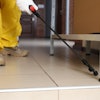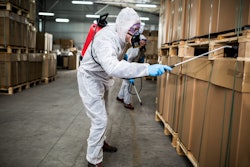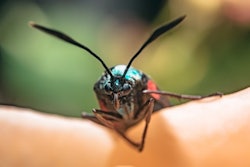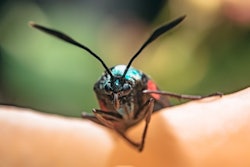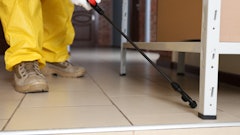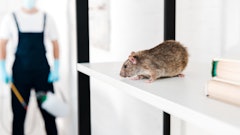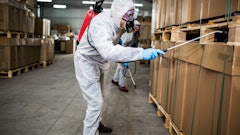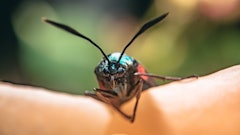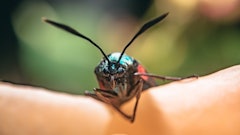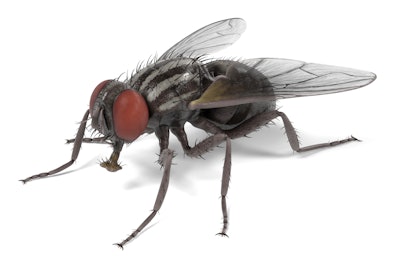
Flies are speedy breeders, disease vectors, annoying and costly if not handled appropriately. A single fly that enters through a door or window can produce hundreds of eggs and carry thousands of harmful microorganisms. To put the risk into perspective, these pests can carry more contaminants than a public bathroom. There are preventive measures you can implement to help keep their bothersome presence and ability to contaminate products to a minimum while ensuring productivity is met. Awareness, identification and being proactive are key to protecting your business and your bottom line.
About flies
Filth flies are generally separated into two groups – larger species and smaller species. Larger species, such as house flies, blow flies and flesh flies, are typically found breeding outside and are strong fliers. The large species of filth flies typically enter buildings through frequently opened doors, windows and even by walking in under a closed door if there is a gap. Smaller species, such as moth flies, fruit flies and phorid flies, are generally found breeding indoors and are weak fliers. The small species of filth flies are often found breeding in decaying organic matter in cracks of floor grout, drains and wall voids. Filth flies thrive in human environments and feed on some of the filthiest substances on earth – food waste, organic build-up, feces, etc. This makes them excellent at helping organic matter decompose but at the same time, excellent at encountering all of the bacteria that can then hitch a ride to the next stop – which might be your plate. It is key to address the source of a fly infestation and not just the flies because flies are never the problem – they’re the symptom of a problem. Because of this, preventive tactics are a key component of an effective pest control program. Some tactics include inspection, sanitation, exclusion and mechanical control.
Inspection
Part of keeping pests out involves ensuring your facility condition is well maintained. Walk through your facility regularly with a pest control provider to address any necessary facility maintenance work or sanitation frequencies that may need to be adjusted.
Inspections help to identify the starting point of a pest problem. In the event of a fly infestation, identifying the present fly species will guide the inspection. To determine conditions, the identified fly species is attracted to, work closely with a pest management professional to find the source of the infestation. A pest control program may also need to be adjusted if there are ongoing issues.
Fun fact: Most filth flies need moisture to reproduce, so their presence is an indication of wet and decaying material.
Sanitation
The foul odor of decomposing food waste is a strong attractant for many fly species. Eliminating these items and their odors can help maintain efficient business operations. Some tips to initiate proper sanitation include:
· Use cleaning solutions that remove organic materials from floor drains and compactor trench drains.
· Move dumpsters as far away from the building as possible and keep the lids closed.
· Work with your refuse management company to routinely clean or rotate the dumpster.
· Consider implementing an odor reduction program that uses bacteria/enzymes to break down, not just mask, fly-attracting odors.
Fun fact: In January 2017, microbiologists published evidence that flies can spread strains of bacteria that are resistant to antibiotics.
Exclusion
Exclusion is a helpful way to keep flies from entering your facility by using preventive methods to help eliminate pest entry points. Exclusion refers to techniques that include repairing and sealing off any common entry points for pests. Even seemingly tiny cracks and crevices in your building’s exterior are an open door to pests. Seal cracks, gaps and holes in doors, windows and walls with caulk or weather stripping. Flies don’t need a lot of space to get in and out of buildings. A well-maintained business can help keep all kinds of pests away.
There are three added benefits of practicing exclusion:
1. Increased energy efficiency and decreased impact on the bottom line
2. Fewer pest problems and more time saved
3. Reduced chemical use
Fun Fact: The right approach to each business environment will be different depending on the factors that attract flies, including geography, climate and type of facility.
Mechanical control
Install preventive equipment like wall-mounted insect light traps, air curtains and other mechanical devices to prevent the presence of flies. These traps can be used in cafeterias, shipping/receiving areas, refuse collection points and food storage areas. It’s important to keep in mind that fly lights and mechanical traps monitor the effectiveness of your overall fly control program and alone are not a complete control option.
Fun Fact: Many companies are skeptical about spending money to replace lighting to draw insects away from buildings, but the investment pays off handsomely in terms of overall pest management expenditures.
Flies are more than a nuisance to businesses. They can transmit diseases, so they are not acceptable at any level. Luckily, there are many effective ways to combat flies. Every fly situation is different, so there is no set blanket approach for this type of pest. Identifying the type of fly plaguing your establishment is the first step toward creating a treatment plan that is right for your business. Remember, flies are never the problem, they are the symptom of a problem. It is important to maintain a fly prevention plan that will ensure the safety of your employees, products, customers and reputation.




